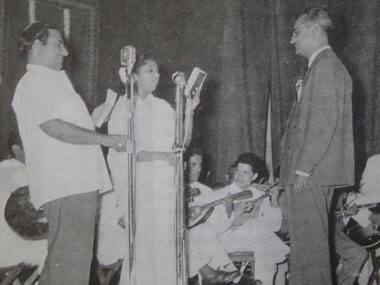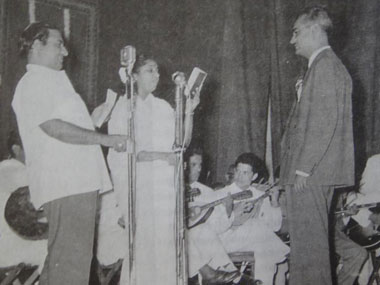There’s thanks to be given to composers Amit Trivedi and Mikey McCleary. Their musical flourishes in the soundtrack of Bombay Velvet have reminded many that Bollywood’s past is as sexy – if not sexier – as its present, at least as far music goes. The songs in Bombay Velvet give you a tantalising taste of the vibrant music of the Fifties and Sixties. Those two decades were the true golden era of Bollywood, with films like Pyaasa, Howrah Bridge, Mughal-e-Azam, Padosan and Aradhana being made. The actors were dashing, the actresses were striking (unlike the cookie-cutter beauties that grace our screens today), the directors were idiosyncratic and the soundtracks were haunting. The fact that one of the most popular tracks in Bombay Velvet is a remixed version of OP Nayyar’s “Jaata Kahaan Hai Deewane” goes to show how truly timeless those old compositions are. [caption id=“attachment_2243730” align=“alignleft” width=“380”]  OP Nayyar (on the right). Image courtesy: Facebook fan page. https://www.facebook.com/groups/265898996948425/?fref=ts[/caption] That said, few music directors can boast of having created melodies with as much lasting charm as Nayyar did. “Opee”, as Nayyar was affectionately called, was not just one of Bollywood’s greats, but a man with enough attitude, drama and talent to his name to merit a film made on his own life. Born in 1926, in Lahore, he lived through some of the most turbulent years in South Asian history with flamboyant joie de vivre and composed music that doesn’t sound dated even today. He didn’t record a single song with Lata Mangeshkar; had feuds with Kishore Kumar and Mohammed Rafi; read the Ramayana in Urdu because he’d never learnt Hindi; drove a Cadillac, and loved Black Label whisky till his last days. At the height of his career, the fedora-clad Nayyar was the most expensive music director in Bollywood and charged in the range of Rs 1 lakh per film, which was an unheard of amount at the time. It was particularly outrageous because Nayyar’s songs were often considered entirely too provocative. For years, All India Radio refused to play some of his songs, deeming them too scandalous for the nation’s sensibilities (as a result, Radio Ceylon was inundated with requests for Nayyar’s songs from Indian listeners). “Jaata Kahaan Hai Deewane” was considered too sexy and was initially cut out of CID by the censor board. None of this perturbed Nayyar, who swanned around town in his fedora and his Cadillac, breaking hearts and building his reputation of being one of Bollywood’s most talented, expensive, arrogant and brilliant music directors. Nayyar was among the first generation of Bollywood composers to take elements from Western music and incorporate them into their own compositions. This isn’t a fancy way of saying Nayyar copied tunes. His songs were unmistakably his own, but they teemed with fragments and details that he’d plucked from sources as myriad as Hindustani classical music and American jazz. He claimed he had no formal musical training and that it was the radio and working in films that had taught him all he knew of music. Whether or not that’s entirely true, Nayyar was certainly more open and irreverent in his compositions than most of his contemporaries. With the help of arranger Sebastian d’Souza in particular, Nayyar created a sound that was distinctive and unconventional. Sarangi and saxophone, guitars and clip-clopping tonga noises, bansuri and Western drums, piano and sitar, velvety voices that oozed sensuality – elements like these came together in Nayyar’s music to create harmonies so fabulous that they made cultural blights like Joy Mukherjee watchable on screen. Here are some of our favourite songs by and stories of OP Nayyar. Tell us your picks in the comments, and happy listening. - Dekho Jadoo Bhare Nain, Aasmaan
This was one of Nayyar’s early compositions and the one that introduced him to Geeta Dutt. Dutt would go on to bring some of Nayyar’s loveliest songs to life and it was because of her that Nayyar met Guru Dutt. Nayyar and the Dutts together created some magical soundtracks. The music director believed Geeta Dutt was among the most underrated singers of her generation. - Kabhi Aar Kabhi Par, Aar Paar
You’ll be hard pressed to find a soundtrack as dazzling as Aar Paar, Nayyar’s second film with Guru Dutt. Every song in it is a gem. This one is an excellent example of the lilting playfulness that characterised some of Nayyar’s most beloved tunes. It’s sung by Shamshad Begum, another early favourite of Nayyar’s. Although her robust voice lost favour with rise of Lata Mangeshkar and the falsetto, Shamshad Begum was one of the most talented singers in Bollywood history and one of the few people who utilised her range was Nayyar. - Aaiye Meherbaan, Howrah Bridge
This song is an excellent example of the drama and sensuality in Nayyar’s compositions that made so many pulses flutter. Of course, the lyrics help the song’s sex appeal, but its assured flirtatious quality comes from the tune rather than the words being sung. Madhubala loved Nayyar’s songs so much that she said that she’d give a discount on her own fee if producers hired Nayyar for her films. - Jawaniya Yeh Mast Mast Din Piye, Tumsa Nahin Dekha
It wasn’t just women who were full of oomph in Nayyar’s songs. Just listen to the mellow, lazy sensuality in Mohammed Rafi’s voice in this one. Rafi – one of Nayyar’s favourite collaborators – also enjoyed the possibility of adding a little drama and voice acting that Nayyar offered. In this song, you can hear him play up the lyrics’ seductive quality, making some words unfurl so languidly that he almost slurs. Nayyar’s love for Rafi’s velvet tones didn’t stop the two from fighting though. Once, Rafi showed up two hours late for a recording session and Nayyar fired him. Rafi was outraged at this and the two didn’t work together for three years. Nayyar tried to find a substitute for Rafi in Mahendra Kapoor (an epic fail), but eventually, the singer and music director hugged and made up. 5. Yeh Hai Bombay Meri Jaan, CID
Nayyar had a justified reputation for being able to lace songs with sensuality, but that didn’t mean he lacked range. Just listen to the playfulness that trickles through this song, which has been an anthem for decades and was famously picturised on the comedian Johnny Walker rather than on the film’s hero. It’s hard to believe that the chirpy energy in this number is from the same singer who was so languid in the previous song, but that’s the genius and range of Mohammed Rafi for you. 6. Yun Toh Hamne Laakh Haseen Dekhe Hain, Tumsa Nahin Dekha
The use of “tonga beats” was one of Nayyar’s most famous triumphs. No one had thought of using the sound of a horse’s hooves like a metronome for a song. Nayyar would use this device in a number of songs over the years. He said that he liked how it rooted the sequence in a specific terrain (somewhat literally). The tonga beats are a wonderful example of the kind of fusion that Nayyar created seemingly effortlessly – the cantering rhythm feels thoroughly local, yet is actually borrowed from Western music. 7. Aao Huzoor Tumko, Kismat
As if Nayyar’s blunt declaration that he didn’t find Lata Mangeshkar’s voice inspiring wasn’t shocking enough, there was the additional scandal that came from the fact that Nayyar’s muse was Asha Bhonsle. Until Nayyar started composing songs for Bhonsle, the singer was very much the lesser-known sister of Mangeshkar and was considered less talented. Nayyar, however, heard the potential and character in Bhonsle’s voice. He also fell in love with her and the two had an affair that lasted almost 20 years. Years later, after the two had parted ways, Nayyar would admit that his love for Bhonsle led to him phasing out Geeta Dutt and Shamshad Begum. 8. Chain Se Hum Ko Kabhi, Pran Jaye Par Vachan Na Jaye
No one remembers this film and the only thing memorable about it is this song, which was actually cut out of the film. This was the last time that Nayyar and Bhonsle would record together. Their tumultuous relationship had just come to an end with Bhonsle walking out on Nayyar (who, incidentally, didn’t divorce his wife. His family would never forgive him this behaviour). The song is almost like an account of Bhonsle and Nayyar’s relationship, poignantly recounting both the passion as well as the pain. “Chain Se Hum Ko Kabhi” would go on to win a Filmfare award, but Bhonsle refused to accept it and didn’t attend the event. Nayyar went on stage instead to receive the award and is rumoured to have thrown it in the garbage on his way home at the end of the evening. For all practical purposes, it also marked the end of his career. 9. Ishaaron Ishaaron Mein, Kashmir ki Kali
Perhaps what unsettled the conservatives about Nayyar’s compositions was that there was no coyness in them, from either the man or the woman. It’s one of the qualities that make his songs feel modern and contemporary even today, decades after they were composed. Instead, there is a playfulness and equality between the man and the woman. As in this song, her sensuality is as frank as his. There’s such an intimacy to this duet that listening to Bhonsle and Rafi singing is almost like eavesdropping in on a conversation, particularly if you don’t watch the video. That said, Shammi Kapoor suddenly breaking out into folk dance moves is one of the greater joys Bollywood can offer, so don’t miss the video. 10. Kahin Pe Nigahen, Kahin Pe Ishaara, CID
Apparently, when Guru Dutt asked Nayyar what he thought of a young Waheeda Rehman, Nayyar replied that she looked like a “Goan ayah”. She wasn’t amused, but thanks to Nayyar, she did get this fabulous song picturised upon her in her debut Hindi film, CID. Sung by Shamshad Begum, this lilting, mischievous track is an example of Nayyar at his best. From sarangi to piano to tabla to the double bass – the melody travels with grace and sweetness. And Shamshad Begum matches with every instrumental lilt with her seductive voice.


)
)
)
)
)
)
)
)
)



